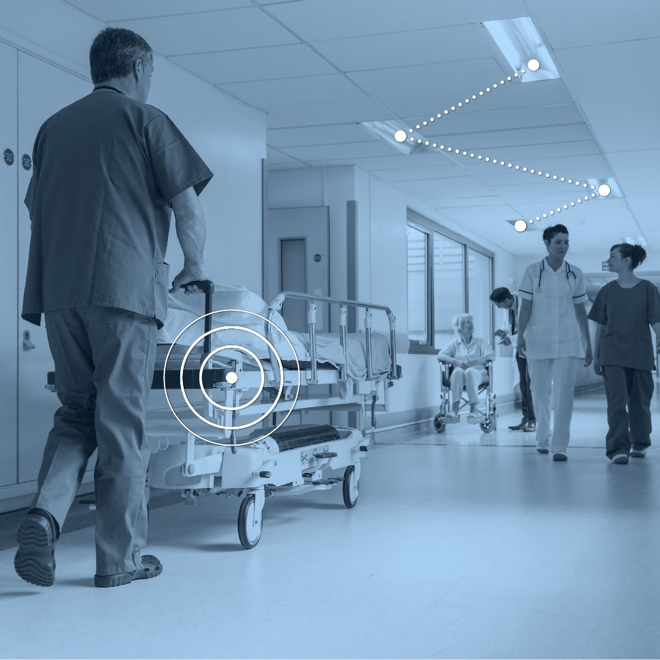For years, Bluetooth® technology has enabled a wide range of location services use cases, from item finding and asset tracking to indoor navigation and access control, and the demand for these innovations continues to grow. According to the 2020 Bluetooth Market Update, the number of annual Bluetooth Location Services device shipments is predicted to reach 538 million by 2024. With a 34 percent CAGR between 2019 and 2024, location services remains the fastest growing Bluetooth solution area.
I recently had a chance to talk with Minako Kudo from Houwa System Design about how they use Bluetooth technology to provide location services, including an innovate solution for locating stored luggage. We also discussed how Houwa’s flagship Bluetooth Low Energy (LE) beacon series is being used to support healthcare facilities, factories, construction sites, festivals, and more.
Q&A with Minako Kudo

How is your beacon solution used to improve baggage finding in hotels?
Houwa System Design, GREENS Co.,LTD. (a hotel operating company that owns Comfort Hotels), and OMRON FIELD ENGINEERING Co., Ltd. jointly conducted demonstration tests on an item finding solution for hotels that consisted of a Bluetooth LE beacon and a dedicated smartphone app. This solution enables hotel staff to quickly locate a guest’s luggage. Attached to luggage left at the front desk, each beacon possesses a unique number, and when that number is entered into the app, the beacon emits light and sound to notify hotel personnel of the location.
We used beacons and a tablet app at the Comfort Hotel Hakata to examine whether the system would help reduce the workload of hotel staff handling luggage left at the front desk.
We received positive feedback from hotel employees who said, “I felt the system helped save time, the tablet app was easy to use, and the system worked smoothly.”
Is your beacon solution used in other areas?
The Bluetooth enabled beacons with built-in speakers and LEDs released in March 2020 are now being used in factories to locate equipment. Owing to Japan’s shrinking labor force, manufacturing industries are finding it difficult to secure the human resources they need to pass their technologies onto the next generation, and they urgently need to improve their operations to resolve this issue.
One aspect that needs improving is the management of precision equipment used in manufacturing processes. With the shift from mass production to small-lot production of a wide variety of products, manufacturers keep a diverse collection of precision equipment on shelves in warehouses that can be over 50 meters long, and searching for the right piece of equipment can take a lot of time.
Also, expensive precision equipment can be misplaced or not maintained properly, resulting in losses. Beacons are a low-cost solution to these challenges.
Our beacon system offers three key advantages.
-
- The beacons can be used on average for five years, and their batteries are replaceable
- All that’s required for the system to work is beacons, mobile devices, and a dedicated app
- The system requires no power supply or installation work
For these reasons, our beacons are being increasingly used in manufacturing industries, and we’re now hoping to grow our market share by expanding our lineup of industry-specific apps.
![]()
FEATURED INFOGRAPHIC
Bluetooth Location Services
See 8 use cases for enhancing building efficiencies and creating a better visitor experience, discover new data that supports the latest trends and forecasts, and find out what’s driving the rapid adoption of location services solutions.
Why did you choose Bluetooth technology to develop your solutions?
We chose Bluetooth® technology for two reasons. The first is that Bluetooth technology is widely used, having been adopted for mobile devices. The second is that detailed Bluetooth specifications are openly available, making it easy to develop new products. With the improved performance of mobile devices in recent years, most of them are now Bluetooth enabled, and the technology has become popular all over the world. We saw this as an opportunity and started to develop Bluetooth LE beacons with the view of expanding the size of the IoT market.
We designed circuits based on the specifications published by the Bluetooth Special Interest Group (SIG), procured and assembled the necessary parts, and created apps that enable customers to customize the signal according to their services. We released our beacon solution in 2014 after four engineers spent three months developing it, and now, seven years later, the beacons are being used as positioning technology in places which GPS and Wi-Fi signals cannot reach. The same technology is being used in a wide variety of scenarios, including contactless payment in smartphones, facility tour guide systems, and locating medical instruments or workers, and we have now supplied over 150,000 Bluetooth LE devices.
What are some other ways Houwa System Design is utilizing Bluetooth technology for location information services?
Our beacons are being used by customers to track children, manage factory transportation operations, provide multilingual tour guide services, and enable location sharing at festivals.
Tracking Children
Our beacons were used in a trial conducted from October to December in 2018 to test functions, such as sending alerts to the smartphones of parents/guardians when their beacon-equipped children reached a specific location.
Press Release (PDF): Trial to Test a Child Tracking Service.
Other Companies Involved: Sompo Japan Insurance Inc., NAVITIME JAPAN Co., Ltd.
Management of Factory Transportation Operations
![]()
Because parts subject to route changes could only be carried by veteran workers, beacons were placed along the routes, and factory vehicle operators used tablets attached to their vehicles to issue route instructions, thereby improving the efficiency of operations. The system also helped reduce transportation operation workloads in the factory by monitoring operator positions to ascertain transportation status and report to a manager in the event of a delay.
Deployment Case Study: Parts transportation operations management system.
Other Companies Involved: DENSO SI CORPORATION.
Multilingual Tour Guide Service
Whenever a smartphone running the tour guide app comes within range of one of the beacons installed in a facility, the service displays relevant information for that point in the tour. The system supports several languages, including Japanese, English, Simplified Chinese, and Korean.
Press Release: Announcing a Tokyo Tower x iBeacon Cityscape Guide App Service.
Other Companies Involved: MUGENSHA, Inc., auris Inc.
Location Sharing at Festivals
This service enables the user to check on the location of festival dancers on a website or smartphone app. The service used our beacons at festival venues in Tokushima and Tokyo of Awa-Odori, the largest and the most famous Bon Festival dance in Japan.
For the Awa-Odori festival held in Tokushima City, Tokushima Prefecture, signals originating from beacons installed on buildings along the dance route were picked up by the app installed on dancers’ smartphones, which then transmitted location information to a server. Based on the location information, the app placed pins on a map on the website to display the location of the dancers in real time.
Other Companies/Organizations Involved: Code for Tokushima, Tokushima University, Tokushima City.
For the Awa-Odori festival held in Tokyo’s Koenji district, beacons were attached to the paper lantern poles located along the dance route so that visitors’ smartphones equipped with the app would send location information to the server upon receiving beacon signals. The smartphone app placed pins on its map to display the location of the dancers in real time.
Other Companies/Organizations Involved: Tokyo Koenji Awa-Odori Association.
Deployment Case Study: Real-time display of the location of the Awa-Odori dance parade.
Which industries do you think will benefit the most from Bluetooth beacon solutions?
That would be the healthcare and construction industries. Our beacons are used in healthcare facilities to locate medical devices in a particular ward. Finding a required device quickly can be critical since any delay in treatment could be fatal.
In the construction industry, our beacons are being used as indicators to reduce the cost of projects by visualizing the utilization rate of forklifts and other construction vehicles with numerical values. Beacons with built-in temperature sensors and accelerometers are also being used for staff health-management and roll-call functions. For example, when excavating in underground sites, there is often not enough light to visually notice accidents or changes in the physical condition of workers. These beacons help provide an added layer of safety and security for those excavating underground.
I believe that beacons also have the potential to help locate personnel in emergency situations where staff may have become immobilized due to an accident.
Are there any other deployment examples in Japan that you can share with us?
We have handled the hardware design, manufacturing, and application testing of the following Bluetooth® LE communications equipment.
Electronic Payment for Vending Machines
“Tappiness” vending machine is a service that enables the use of LINE Pay, and other LINE Corporation services, by connecting beacons to vending machines. Kirin Beverage Company, Limited have deployed the service nationwide, and the number of machines equipped with such beacons topped 50,000 in July 2019.
Source: https://www.kirin.co.jp/company/news/2019/0808_04.html.
What kind of market issues do you think Bluetooth technology has helped resolve?
In construction industries that handle urban development, work environments must adapt accordingly to each project, and construction companies need to invest in equipment for measuring actual utilization rates and waiting times of transportation vehicles.
However, most such products that meet environmental performance requirements are prohibitively expensive. Bluetooth® technology is being used to solve this issue. More specifically, beacons equipped with various sensors are attached to the vehicles to be measured. Sensor data originating from these beacons can be transmitted through receivers to a server and turned into graphs by the user’s software to predict equipment failure rates. Initiatives like this that visualize and improve operations are being implemented in construction, healthcare, and various other industries.
Do you have any plans to use Bluetooth direction finding capabilities?
We are developing products compatible with the latest version of the Bluetooth® specification. Although we have not yet decided on a definite release date, we are making preparations to incorporate new Bluetooth features into existing products to further increase positioning accuracy. At the same time, we publish our research results on our official blog, and through such activities, we hope to contribute to the further advancement of Bluetooth technology.
![]()
FEATURED PROGRAM
Bluetooth Member Promotion Program
Are you a Bluetooth member designing innovative wireless solutions? You may be eligible to participate in the Bluetooth Member Promotion Program.





































